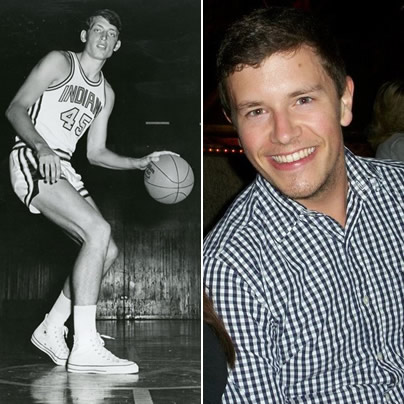Living
Back to School: How it got better at William & Mary
Trammell on the importance of mentoring new generation


The future rector, Jeff Trammell (class of 1973), was captain of the basketball team. (Photo courtesy of Trammell)
Editor’s note: This is the second installment in the “Back To School” series assessing the LGBT climate on university campuses as told by alumni we’re pairing with current students to tell their stories. This week: Jeff Trammell and William & Mary. Next in the series: Lesbian author Fay Jacobs returns to American University.
Speaking of her beloved college, the acclaimed actress Glenn Close once said, “I have an indestructible, visceral connection to this place — a connection which is vital and real and which has sustained me through good times and bad.”
This loving endorsement of William & Mary by Close threads the needle for this series. As we explore the experiences and struggles of gay alumni, the actress known for her roles in “Dangerous Liaisons” and “Fatal Attraction” serves apt imagery.
For Jeff Trammell, in the early 1970s, any same-sex liaisons would have been dangerous — and any attraction could be fatal to his reputation, or worse.
So, while heterosexual classmates were sewing their wild oats, Trammell buried himself in books, basketball and life in the Lambda Chi fraternity. One can picture him with 20 pounds of history books in his backpack, waiting in line to use a public pay phone to call his “date” — a coed with whom only polite conversation would take place. No liaisons, no attractions. The oats he sewed were mild. He only risked coming out once, quietly, to his straight little brother in the fraternity. Much later in life, Trammell would come to lead the Lambda Alliance for LGBTQ’s, but, typical of Trammell, he didn’t drop his ties to Lambda Chi. To this day he is thankful to — and a dear friend of —his little brother and sole confidant, Dave Blount.
Trammell took one shot at wild oats back then. It was a secret mission into D.C. to check out the legendary gay bar, Lost and Found. He arrived at 7 p.m. and entered solo. The bartender just laughed and said, “Come back at 11.” The star senior hoopster was a rookie in gay life so he anxiously sat out in the parking lot. Once inside at the stroke of 11, he saw men dancing with men. As he puts it, “Breathtaking.” But, across the crowded dance floor he spotted the captain of the tennis team, and frightened, he slunk into the shadows, “which is not easy at 6’7″.”
Like many southern boys, Trammell relies on those immortal words from “Steel Magnolias”: “That which doesn’t kill us makes us stronger.” And strong is an understatement. Settled down with Stuart Serkin, his husband with whom he has danced for 36 years, they laugh at having met taking the Florida Bar exam — and Serkin had to coax out of Trammell that his great uncle was indeed “that” former Gov. Trammell of Florida. Their first date was to see “Who’s Afraid of Virginia Woolf” and here they are 36 years later watching the potential reality horror show “Who’s Afraid of Virginia Under Ken Cuccinelli?” But, ever present in their politics, both are at the barricades working for Democratic gubernatorial candidate Terry McAuliffe.
Trammell has worked for Democrats on Capitol Hill for decades, run LGBT outreach for both the Al Gore and John Kerry campaigns and gone toe-to-toe on gay issues with the likes of Sean Hannity and Bill O’Reilly on Fox News. Throughout his life, he has always stayed involved in William & Mary alumni affairs. Last year, he agreed once again to mentor an undergrad — this time Davey McKissick, a senior whose experiences are quite different.
First off, McKissick’s books and phone are both on his iPad, and literally balanced in the palm of his hand. In his other hand? His boyfriend’s. No pay phones, no book bags, no coed “beards.” And if McKissick were single and ran into a gay tennis player, he wouldn’t feel the need to run away. He leads an authentic life. He has learned his gay history through documentaries, lectures at W&M and through Trammell. His ambition was to intern in D.C. and among the 15,000 alumni in the D.C. area, he’s sitting at Trammell and Company with Jeff — the first openly gay board chair (rector) of a major university.
William & Mary elected the first openly gay board chair of a major university in the United States. It didn’t happen in Cambridge, Berkley or Madison. It happened in Williamsburg, Va. “I owe it all to the GALA students and faculty at the university,” Trammell said. “They created the climate for this to happen.” There are many reasons to look up to this former basketball star, and his height isn’t even at the top of the list. Start with McKissick’s gay hero, Barney Frank. It so happens that Trammell co-founded Stonewall Democrats with Frank, so the next thing you know, bang, McKissick is shaking hands with his hero. McKissick is interested in LGBT outreach at the DNC, and poof, he’s sitting in the director, Jeff Marootian’s office, working the Obama-Biden campaign.
When not mentoring students, Trammell can be found funding LGBT lectures at W&M with Chris Bram, fellow alum and the author of “Gods and Monsters,” or helping to fund the Boswell Project, named for John Boswell, class of 1969 — the historian of same-sex relationships in the middle ages. Ironically, Boswell was lost in the AIDS plague. Or you can find Trammell working with David Mixner on the gay issues documented in the U.S. Holocaust Museum. He’s been appointed to the board of the Association of Governing Boards of Universities and Colleges, which represents 38,000+ trustees across the U.S. He’s answering his Blade interview questions at 1 a.m. and then at press time, he’s on the front page of the Washington Post dealing with the new tuition structure. Throughout, his trips to Williamsburg and Richmond are frequent.

Davey McKissick (class of 2014) has led a very different life on campus than his mentor, Jeff Trammell (’73), at William & Mary. (Photo courtesy of McKissick)
Back in Williamsburg, McKissick has already navigated the same gauntlet of traditions Trammell did — swimming the Crim Dell pond, jumping the wall of the Governor’s Mansion, and running the Sunken Gardens. But today, gay campus life is lived in Technicolor with Pride festivals, movie nights and the occasional drag show. There are “safe zones” throughout campus, letting LGBT students know they are welcome.
Reflecting on all this change, Trammell recalls his mother’s reaction late in life to his coming out post-college.
“Well, she was very WASPy and southern and that adds up to being polite,” Trammell said. “She said ‘Oh, honey, I’ve known that for a long time. Now, we don’t need to talk about it’.”
He got unconditional love, but conditional parameters for discussing it. McKissick’s answer to the question about his straight heroes is heart-warming. He answers: “Betty and Ron.” That would be his parents, the McKissicks.
“I could not ask for more supportive influences in my life,” he said. “They motivate me to set high goals for myself and to be relentless in achieving them.” Betty and Ron have no problem talking with — or about — their son.
“It’s remarkable to see Davey is fully out and authentic, things not possible for me back then,” Trammell said. “I think no matter what the size of your alma mater, gay alums should get back involved and support their students.”
As rector, he will officiate commencement at William & Mary Hall this summer, on the same floor he played his first basketball game.
The college marks 1918 as admitting the first woman student and 1951 the first African American. Gays have been there since 1693, but the price to pay for being admitted was no admission of who you were. Those days are steadily fading behind us. Because of its history, W&M has been called “the alma mater of a nation:”
Hark the students voices swelling
Strong and true and clear
Alma Mater’s love their telling
Ringing far and near
Today, each student’s voice is strong and clear. Liaisons aren’t dangerous and attractions aren’t fatal to your reputation. LGBT alumni proudly join Glenn Close in a visceral connection that has sustained them all through the years.
And so, even from a famed Sunken Garden, when he’s standing on Trammell’s shoulders, McKissick can see nothing but rainbows in a clear blue sky ahead of him.
Read the previous installment of this series at washingtonblade.com. If you have alumni stories to share, reach Brent Mundt at [email protected].

Did you melt like the Wicked Witch of the West this week?
As summer temperatures rise, keeping your home or apartment cool during a heat wave can become both a comfort issue and a financial challenge. One of the most effective ways to keep a home cool is to prevent heat from entering in the first place. Sunlight streaming through windows can significantly raise indoor temperatures. Consider the following solutions:
• Close blinds or curtains during the hottest parts of the day. Blackout curtains or thermal drapes can reduce heat gain by up to 30%.
• Install reflective window films to block UV rays and reduce solar heat without sacrificing natural light.
• Use outdoor shading solutions such as awnings (yes, the ones you removed because they were “dated”) and shutters to limit direct sunlight.
Fans are a cost-effective way to circulate air and create a wind-chill effect that makes rooms feel cooler.
• Ceiling fans should rotate counterclockwise in the summer to push cool air down.
• Box fans or oscillating fans can be placed near windows to pull in cooler evening air or push hot air out.
• Create a cross-breeze by opening windows on opposite sides of your home and positioning fans to direct airflow through the space.
• For an extra cooling effect, place a bowl of ice or a frozen water bottle in front of a fan to circulate chilled air.
To optimize natural ventilation, open windows early in the morning or late in the evening when outdoor temperatures drop. This allows cooler air to flow in and helps ventilate heat that built up during the day.
Appliances and electronics generate a surprising amount of heat. To reduce indoor temperatures:
• Avoid using the oven or stove during the day; opt for no-cook meals, microwave cooking, or grilling outside.
• Run heat-producing appliances like dishwashers and clothes dryers in the early morning or late evening.
• Unplug electronics when not in use, as even standby power can add heat to your space.
• Switching to energy-efficient LED lightbulbs can also reduce ambient heat compared to incandescent lighting.
If you do use an air conditioner, maximize its effectiveness by:
• Setting it to a reasonable temperature—around 76–78°F when you’re home and higher when you’re away.
• Cleaning or replacing filters regularly to maintain airflow and efficiency.
• Sealing gaps around doors and windows to prevent cool air from escaping. (Didn’t we all have a parent who said, “Close the door. You’re letting all the cool out?”)
• Using a programmable thermostat to optimize cooling schedules and reduce energy use.
If it is not cost-prohibitive, adding insulation in attics and walls can greatly reduce heat transfer. Solar panels that reflect heat can also help, as well as offset the cost of their installation. Adding weatherstripping around doors and windows, sealing cracks, and using door sweeps can make a significant difference in keeping heat out and cool air in.
Natural and eco-conscious methods can also help cool your home.
• Snake plants, ferns, or rubber trees can improve air quality and slightly cool the air through transpiration.
• White or reflective roof paint can reduce roof temperatures significantly.
• Cooling mats or bedding can make sleeping more comfortable without cranking up the A/C.
For renters or those who can’t make permanent modifications, there are still plenty of ways to keep cool.
• Use portable fans and A/C units instead of built-in systems, making sure they are the correct size for your space.
• Removable window film or static cling tinting can reflect heat without violating your lease.
• Install tension rod curtains or temporary blackout panels instead of hardware-mounted window coverings.
• Add draft blockers and weatherstripping tape that can be applied and removed without damage.
• Cover floors with light-colored rugs to reflect heat rather than absorb it.
• If allowed, use temporary adhesive hooks to hang reflective materials or light-filtering fabrics over windows.
Even if your space is warm, you can still take steps to help your body stay cool.
• Wear light, breathable fabrics like cotton or linen.
• Stay hydrated and avoid caffeine or alcohol during peak heat hours.
• Take cool showers or use damp cloths on your neck and wrists to bring your body temperature down.
Keeping your home or apartment cool in the summer doesn’t have to be expensive or energy-intensive. With a few adjustments such as blocking sunlight, optimizing airflow, using fans effectively, and making renter-friendly upgrades, you can create a more comfortable indoor environment while keeping energy bills in check.
Valerie M. Blake is a licensed Associate Broker in D.C., Maryland, and Virginia with RLAH @properties. Call or text her at 202-246-8602, email her at DCHomeQuest.com, or follow her on Facebook at TheRealst8ofAffairs.
Real Estate
The world’s on fire and D.C. is on sale (sort of)
Prices are up, but then again, nothing makes sense anymore

ICE is disappearing people, revered government agencies are shuttering, and who knows if we’ll be in World War III next week? But can you believe prices in D.C. are actually still up 6.3% since last year? It doesn’t make sense, and perhaps that does make sense, because nothing seems to make any sense any more.
That said, there are some parts of our market that are truly suffering. The interest rates, which have been up, up, up for about four years now, are the ongoing rain on our market’s military parade. Combine that with 75,000 federal employees taking a buyout nationwide, and DOGE cuts eliminating around 40,000 federal jobs in the District (per estimates by the D.C. CFO), not to mention thousands of other job losses in non-governmental organizations due to funding and program cuts, and you’ve got a case of uncertainty, and downright unaffordability in the pool of otherwise would-be buyers.
This has had a marked impact on properties that starter-home buyers and low- to mid-level employees would otherwise buy, most notably condominium and cooperative apartment units. These properties have already slowed in our market thanks to the profound impact that higher interest rates have had on their monthly carrying costs—pair that with job insecurity, and a lot of condos are proving to be very difficult to sell indeed.
So how is the average sale price up in our market?
The increase is almost entirely due to the resounding strength of the single-family home market, especially in upper Northwest D.C., where it is still quite common to see bidding wars, even on properties pushing past the $3M mark. It seems that buyers in that echelon are less impacted by a few percentage points in the interest rate, and less concerned about their job security. Notably, those buyers are often married with children and have an absolute need for more space, must stay in the area due to one spouse’s job, or the kid’s friend group, regardless of whether the cost of owning is thousands of dollars more per month than it would have been in 2020 or 2021. The continued appreciation in these neighborhoods defies imagination.
So, what to do if you are not one of those lucky enough to be shopping for a $3M home? The short answer: wait. If you want more space, rent your current place out and learn the joys of being a landlord while someone else pays your mortgage. Need the equity from your current home to buy your next place? Get a home equity line of credit, or loan, and pull the equity out of your current place to buy the next one. Or—and I have never recommended this before in 21 years of being a Realtor—rent for a few years. Sure, I’d love to list and sell your condo so you can climb the real estate ladder, but it might just be a waste of time, money or both if you could just ride out this storm and sell in a DOGE-less future.
All this said, there are some condos that seem to be immune from this recent negative news. Anecdotally, it feels like it’s the truly special ones that do just fine no matter the market. Our recent listing in Capitol Hill had a view from every one of its 15 windows of the Supreme Court. Sold in five days with six offers. Another condo was on the top two floors of a townhouse and had the coolest black wood floors that gleamed like a grand piano. Sold in four days at full price.
So, all is not for naught if you have a condo or home in an area that people want to be in, with nice space, light, amenities and a certain je ne sais quois. And, as long as we have a democracy in a few years, my experience says our market will be back, stronger than ever, really soon.
David Bediz is a Realtor and mortgage loan broker for the Bediz Group LLC and Home Starts Here, LLC. Reach him at [email protected].

In this corner, there’s the Genesis QV70, newly updated and full of glitzy gizmos. And in the opposing corner, there’s the Lexus NX, a fan fave known for comfort and reliability.
Both are strong contenders. Both have proven to be equally adept at bobbing and weaving through traffic. And both can go toe to toe with pricier competitors.
And yet, what would happen when they sparred against each other? Here’s your ringside seat to find out.
GENESIS QV70

$50,000
MPG: 22 city/28 highway
0 to 60 mph: 5.9 seconds
Cargo space: 28.9 cu. ft.
PROS: Stylish. Good value. Lots of standard amenities.
CONS: So-so fuel economy. Quirky dash controls.
IN A NUTSHELL: When it comes to speed, the Genesis QV70 is faster on its feet than the Lexus NX. Neither of these crossover SUVs is a lightweight, but the QV70 offers more potent powerplants—including an all-electric version that zips from 0 to 60 mph in just 3.8 seconds. In other words, Porsche Macan S territory.
The two gas-powered options—a four-cylinder turbo and twin-turbo V6—also got my blood pumping. So did the velvetlike suspension mixed with deft handling and stop-on-a-dime braking. But this adrenaline rush comes at a cost: sacrificing fuel economy.
As for the automaker’s design philosophy—“athletic elegance”—it’s on full display here: an oversized grille inspired by the Genesis emblem, the dramatically arcing silhouette, and those distinct quad headlights and taillights. It’s not easy to stand out when 25% of all vehicles sold in the U.S. are compact crossovers, so kudos to the QV70 for being such a head-turner.
The mod-yet-minimalist styling carries over to the cabin, with its high-quality materials: real-wood accents, soft-touch plastics and a tasteful glass shift knob. New this year is a sweeping 27-inch dashboard monitor, which houses the gauge cluster and infotainment touchscreen. Alas, this display is positioned a bit far from the driver (though I must admit reaching for it did help stretch a few tight back muscles).
Instead of being a costly extra, this gigantic monitor comes standard. So do synthetic leathers seats, nine-speaker stereo, smartphone/wireless connectivity, hands-free liftgate, tons of safety gear and more. Options include a panoramic sunroof, three-zone climate control, 16-speaker Bang & Olufsen audio, synthetic suede headliner, sound-reducing rear windows, automated parking and other goodies.
What’s the score so far? Despite some minor quibbles, the Genesis QV70 is a worthy challenger that pulls no punches.
LEXUS NX

$43,000
MPG: 26 city/33 highway
0 to 60 mph: 8.2 seconds
Cargo space: 22.7 cu. ft.
PROS: Fuel efficient. Comfy seats. Rock-solid reliability.
CONS: Pokey base model. Limited rear storage.
IN A NUTSHELL: Sure, the Lexus NX isn’t as speedy as the Genesis QV70. But, as with the tortoise and the hare, sometimes slow and steady wins the race. And really, it’s only the entry-level NX that feels sluggish, such as when trying to quickly merge into freeway traffic.
Other trim levels, including two hybrid options, are just fine. And no matter the engine choice, the counterpunch here is that these vehicles get better gas mileage: 20% higher fuel economy than in either the four-cylinder or V6 in the Genesis. The two NX hybrids are even more green, with the high-end plug-in version able to travel up to 37 miles on electric power alone. One downside: There is no all-electric NX—well, at least not yet.
As with parent-company Toyota, Lexus offers stellar vehicle reliability—often ranked No. 1 in dependability and crash-test surveys year after year. Lexus vehicles generally hold their value better than Genesis, because this newer brand has a shorter history. Lexus also has a larger dealer network, though the number of Genesis dealerships is growing.
But when it comes to cargo space, the NX is about two inches shorter and narrower than the QV70, which has more stowage area. And Genesis handling is sportier, though the Lexus feels sure and well-grounded.
Luxe interior amenities are basically the same in both vehicles. But interior styling in the QV70 is trendy, while the NX is more understated. In other words, a choice between sassy and classy.
This is a very competitive vehicle segment, with Euro models like the Audi Q5, BMW X3 and Mercedes GLC also duking it out in what seems like a clash of the titans.
But as for the Genesis QX70 or Lexus NX, which is the winner? For me, both are real knockouts—so I’d call it a draw.


















